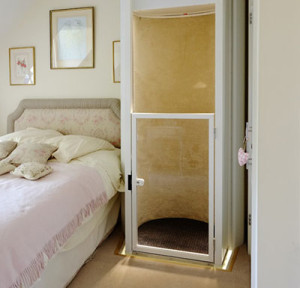22 Jan 2018
Personal Elevator Benefits Pacifica, California
Hello, my name is Paul Harlin with Lift and Accessibility Solutions. I’m here to introduce you something newer to the U.S. market called a personal elevator. This happens to be a Wessex that comes out of England.
What makes something a personal elevator is the fact that it’s an elevator that doesn’t require a shaft. It’s allowing us to travel between two floors here at a home in Pacifica, California. While not happening to wall off the space permanently and either the room it’s up or down. So, as this elevator starts up and moves out of the downstairs level, you’re going to see that we can actually see the walls behind this space. And use the space, we could actually stand under that space. The volume of that air is available in the room. In a minute we’ll I’ll join you upstairs to show you what it looks like as it’s coming up.
Now we’re on the second floor of the elevator. Showing you what it looks like in the room as the elevators coming up. You can see pictures on the wall, you can see where the room had plenty of room in it. As the elevator is starting up, the elevator is going to come in and fill in a corner of the room. Allowing someone to bring a wheelchair, a scooter, maybe it’s just the suitcase that’s coming back from a trip. Coming up into that second level and just having free motion between two floors in a home. Once the elevators up we open the door and someone is able to exit.
Once that is complete if you want more room at this level you’re just going to send the elevator back down again. And, have the room to use how you would like.
If you have any questions about this that we could answer. Please feel free to contact us at the information below at the addresses below. My name is Paul Harlin with lift and Accessibility Solutions.
We have all experienced that sinking feeling when you walk in a building and head toward the elevator and see that out of service sign. That feeling of annoyance is fleeting once you have left the building and gone about your day.
Now, imagine if it were your home elevator that was broken. That feeling of annoyance would sit with you until it is repaired. Along with that very real emotion that comes with feeling like you are cut off from a portion of your home. Well, with that in mind here are a few simple things to keep in mind with your home system. Not doing these things will help keep it running smoothly for the extent of its life.
Running At Overcapacity
Having an elevator may seem like an easy way to take heavy loads from one floor to the next. Yet one of the fastest ways to shorten the life of your home elevator is by running your system overcapacity. This forces every part of your elevator to work harder to make the lift from floor to floor.
If you run your elevator overcapacity regularly you will likely begin to notice that it will start to run at uneven speeds.
Holding The Door
Do not interfere with the doors of your elevator as they close. Blocking your elevator doors might seem like a good idea to “hold” the elevator to get everything or everyone in the lift. But in fact with many newer elevator lift systems you can “time out” the elevator by holding the doors open. The resulting “time out” will then need to have a mechanic restart the system. If you need to keep the doors open longer than programed use the DOOR OPEN button that should be located on the selector panel.
Shenanigans
So, we all have been there as a kid and likely many of us have as adults as well we are in the elevator and it is descending to the ground floor. Just as we sense it is about to come to a stop we jump up and down. Well, it sure sounds fun and it was when were kids but unfortunately this action is very hard on your elevators lifetime as it puts stress on numerous parts of the lift. So, don’t bow to the temptation yourself or allow other people using the elevator to.
Forcing The Doors
Lastly it may seem like common sense but never try to pry open the doors while in the elevator. If you do manage to force the door open you can risk injuring yourself. Additionally, by forcing doors open you can damage the system resulting in the need for time consuming unnecessary repair to your elevator.
25 Mar 2017
Accessibility Makes a House a Home
Architects have long debated how important a building’s design is. Some have come to the conclusion that the appearance of a building is just as important as its purpose, or perhaps even more so. Others hold the opinion that form must follow function- a drafty and leaky building will fail to adequately protect its occupants, regardless of its visual beauty. A related principle stands out either way: if the intended occupants of the building can’t access it easily, then the building has clearly outlived its usefulness. This is as true for individual houses as for grand civic structures.
All buildings are a means to an end- that of shelter from the elements- but there’s something special about a home. Most of us spend the majority of our time in our homes, and frankly, we’d rather be there than in the office, because home is where the heart is. It’s where family is, and where many of our best memories are made. It’s a place that we want to associate with rest and enjoyment.
Of course, we don’t remain the same during our entire lives. People grow and change, and adapt to new circumstances. Often our homes start to represent something different in the context of those changes. Buildings don’t simply adjust themselves in the way their occupants need. Many buildings that were once of great use to thousands of people are for this reason abandoned to the elements, but who wants such a fate for their beloved home? Anyone who has invested so much time and effort in the beautification of their home would hardly feel satisfied with such an end, even if the staircase has lately become more of a burden than a help.
Fortunately, human ingenuity has now made it easier than ever before to adapt a home to the changing requirements of life. Technologies like motorized chair lifts can bypass the steps of any staircase, regardless of shape. That key feature of a multistory home no longer need imply the wearing down of its user’s knees, or demanding the assistance of another resident. A more attractive but more design-intensive technology like a home elevator can accomplish the same useful purpose of improved accessibility, while adding a customized touch of architectural sophistication. Above all, they provide a home’s occupants with that cherished feeling of independence. Having outdoor steps turned into a ramp, installing swing away doors, widening doorways, lowering thresholds, and installing grab bars are also important and simple ways to adapt the home.
Our houses are, as one architect put it, “machines for living.” They should serve us, rather than wear us out. Even so, we feel attached to them, and we want them to be places where we can be happy and comfortable for many years. A proud and independent homeowner would therefore do well to consider the value of these adaptations that can help a house remain a home.
21 Apr 2015
Personal Home Elevator Safety Features
 Whether you’re looking to install a home elevator for increased functionality or to boost the value of your home, safety is always our top priority. When you rely on the Stiltz model of in-home elevators, you are gaining a safe addition to your home. In this post, you will learn about the many systems in place to keep you and your family safe when an elevator is being built and used in your home.
Whether you’re looking to install a home elevator for increased functionality or to boost the value of your home, safety is always our top priority. When you rely on the Stiltz model of in-home elevators, you are gaining a safe addition to your home. In this post, you will learn about the many systems in place to keep you and your family safe when an elevator is being built and used in your home.
In America, every Stiltz home elevator comes with a door. The door is either a half-height or full-height door. This door will not open until the elevator comes to a complete stop either at the top or bottom floor. Additionally when the elevator is built, a hole will need to be cut into the top floor. A safety lid will plug the floor upstairs keeping everyone safe.
One safety feature that can protect your family and even your pets is the safety sensor pan. Located on the top and bottom of the lift, this sensor will identify if an object has obstructed the elevator’s path. If something is in the way, the elevator will halt its movement and not resume in the direction of the obstruction until it is removed whether that’s a housecat or some object like a chair.
The Stiltz home elevator has a safety feature that also determines if the weight limit is exceeded. The Stiltz Duo Lift can carry one or two passengers for a total weight of 375 pounds while the Trio can carry up to three passengers for a total weight of 484 pounds. To keep operation completely safe, the elevator is equipped with a limit sensor that determines if the weight is exceeded. If it is, the elevator will not run until a safe weight limit has been reached.
Other safety features of the home elevator include:
- Out of balance sensor that will prevent the lift from running if for any reason it is out of balance.
- In the unlikely event either steel cable in the unique drive system breaks, every elevator is equipped with a fall arrest mechanism that will prevent the elevator falling.
- If the lift travels faster than it is supposed to, your overspeed sensor will return it to safety.
- If a power outage occurs, the lift is equipped with a backup battery.
If you have any questions about the Stiltz home elevator, please contact us today!
21 Mar 2015
Compact Design Of A Stiltz Personal Elevator
Hello, my name is Paul Harlin with Lift & Accessibility Solutions here at a client’s home in Windsor, California, to talk a little more about the Stiltz Personal Elevator.
Now, one of the things that we said about the Stiltz is it has a smaller footprint, but what’s also important is what happens when it can leave the room. Because of the way the Stiltz is designed, when we run the Stiltz up, all we have left is a couple little stilts in the room, and we recover that whole volume in the room, as you can see the Stiltz going up and going through the ceiling. Now, I’m free to walk and move in this space and still use this space in the room. I still have view of the window out behind me, and I didn’t give up the volume in this room even though I have the ability to carry person or possessions between floors in the Stiltz Personal Elevator.
I hope this is helpful information. If you have any questions, please feel free to contact me at the information listed below. Thank you very much.
10 Mar 2015
Features of The Stiltz Residential Elevator
Hello, my name is Paul Harlin with Lift & Accessibility Solutions. I’m here at a client’s home in Windsor, California, to show you some of the features of the new Stiltz Personal Elevator. A nice feature about this elevator is it’s open car design. We’ve got a half door with a light curtain above it. So, even when we’re in the elevator, we don’t feel like we’re closed or cause claustrophobic. We have the openness into the room where we’re entering from. And yet if we’re in an upward motion, and I were to stick my hand through where I might be in danger, the car is just going to automatically stop until I withdraw my hand again.
This is just one of the many safety features and the convenience of the Stiltz Personal Elevator. If you have any questions or would like more information about them, please contact me at the address listed below. Thank you.







